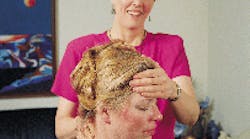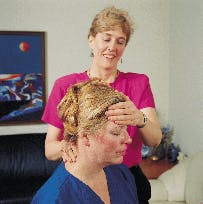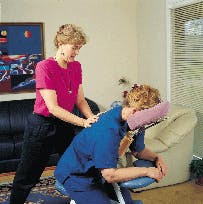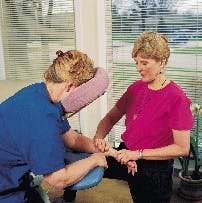Massage helps relieve aching muscles, so why not invite a therapist to the office?
Mary Martha Stevens, RDH, PhD
If I had supreme power over the dental profession, I would grant every dental hygienist at least one 15-minute, on-site massage a week. Aches and pains might then become a thing of the past.
My knowledge about on-site massage comes from working with employees at the Puritan-Bennett Corp., in Overland Park, Kan., for many years. At that time, I was manager of health and wellness for the number-one maker of respiratory care products worldwide. My job was to facilitate a healthy work environment. I approached this task by forming employee work groups to assist me in designing health promotion activities for the rest of the company.
One of the most popular programs was on-site massage. Two female employees who had been with the company for 25 to 30 years initiated the program. They were adamant that, after years of working in the same position all day, their bodies deserved some tender loving care. Their enthusiasm came from reading about this new craze that was sweeping corporate America. This phenomenon possibly was occurring in response to what John Naisbitt, author of Megatrends, had foreseen when he wrote, "The more high technology around us, the more need for human touch."
The benefits of massage are impressive. Even the chairman of the H.J. Heinz Co., who participates regularly in on-site massage and pays a portion of his employees` costs, swears by the good effects. Although Heinz had the foresight to be one of the first, he is, by no means, alone. Apple Computer, the City of Orlando, the Cystic Fibrosis Foundation, Merrill Lynch, NBC-TV, Sony Music, the University of California Medical Center, and the Washington State Department of Health are just a few of the organizations using on-site massage to increase employee well-being and reduce health-care costs.
Laura Miller, LMT, a licensed massage therapist from Overland Park, says, "When muscles are relaxed, the mind is relaxed. Not only does massage relieve tension, but it also improves blood circulation and lymphatic drainage, improves posture and skin tone, and stimulates a balanced condition of the autonomic nervous system. It also helps to reduce pain and inflammation of the joints."
Tim Duffy, CMT, LMT, owner of The Knead Clinic in Olathe, Kan., concurs. "Most people live in a world where the fight or flight response is always active," he says. "Some of these people never get a break from this response. Pain is experienced when muscles are tight and stay tight. Generally, people know when they hurt. But sometimes they have gotten so use to the pain, they don`t even know that it`s there. Massage helps the body return to a more normal state, a relaxed state. Massage promotes healing, increases flexibility, reduces blood pressure and aids in removing toxins from the body. The increased blood supply to the muscle tissues aids cellular nutrition which, in turn, enhances the overall work capabilities of these tissues."
Although its roots go back thousands of years, therapeutic massage recently has been able to shake the seedy massage-parlor image to become one of the most exciting professions in the United States. This is happening because people all over the world are seeking ways to relieve the stress and tension in their lives.
Even medical doctors are realizing the value of this ancient healing technique. The American Massage Therapy Association (AMTA) reports that, in West Germany, medical doctors are as apt to write a prescription for massage therapy as they are for tranquilizers. Therapists in China and Japan work closely with doctors as a part of the health-care team.
On-site massage, also referred to as chair massage or seated massage, became popular in 1986 when David Palmer, a San Francisco masseur, developed a unique, portable massage chair. In 1989, The Wall Street Journal quoted Palmer as saying, "The culture is not ready to take off its clothes, lie down and be touched for an hour for $45. The idea is to keep the clothes on and to keep people seated. The chair is a way to package massage."
Other benefits of on-site massage are that they:
- Reduce the physical and mental effects of stress, helping to prevent burnout and stress-related diseases.
- Reduce the adverse effects of sitting for long periods of time in the same position.
- Relieve physical problems associated with repetitive tasks.
- Improve alertness and the ability to focus.
- Relieve tension headaches, as well as stiff and sore muscles.
- Improve immune system functioning for better general health and resistance to colds and other illnesses.
- Increase good feelings about the workplace and loyalty to the employer or company that cares.
- Leave employees feeling revitalized and ready to return to work
Feeling good about who touches you
"The first massage session is vitally important to whether a person will continue with the therapy," says Duffy. "If a person is not comfortable with the therapist, they shouldn`t give up. It could be that they haven`t found one that suits their needs and personality. And, this is really important."
Julie Hajebian, LMT, who has practiced table massage and on-site massage for the past three years, says that you should make sure that the therapist is licensed and has received professional training. Hajebian, who is hearing impaired, received training at a private Kansas City school. She is now attending Johnson County Community College in Overland Park to receive certification, where she feels the training is much more in-depth and professional in scope. The Therapeutic Massage Certificate Program at Johnson County Community College requires students to complete 500 hours of coursework within 18 months. Students take anatomy and physiology, 250 hours of supervised clinical body work, two semesters of kinesiology and pathology, hydrotherapy, first aid/CPR, communicable diseases and several semesters of professional business practice.
At Touch Works Massage Therapy Clinic, Inc., in Olathe, Kan., Hajebian has worked on dental hygienists and dentists who tend to have similar problems due to the static nature of their work. In addition to therapy, she has taught them stretching exercises to prevent problems in their hands, arms, shoulders, neck and back.
"If only dental hygienists were able to work on both sides of the patient, they wouldn`t strain the muscles on one side of the body so much," says Hajebian. She indicates that poor posture is the real culprit as well as not breathing properly while working. "A good massage therapist can teach a dental hygienist simple stretching and breathing exercises that will relax the body and help prevent injuries."
Massage therapists use a variety of techniques to relieve tension in muscle tissues and restore the body`s natural healing mechanisms. The therapists I interviewed used some or all of the following techniques:
- Swedish massage to increase relaxation and circulation.
- Sports massage to reduce or eliminate factors that interfere with performance.
- Deep-tissue massage to work on tight areas to release tension and restore flexibility.
- Trigger-point therapy to help break the cycle of spasm and pain in a particular area.
- Soft-tissue release (STR) to provide relief from sore muscle tissue and chronic muscle tightness.
- Various types of Oriental acupressure techniques from Shiatsu, Tuina and Thai Massage.
Jason Ford, LMT, owner of Touch Works, says that most on-site massage therapy costs $1 per minute. All of his therapists are members of Associated Bodywork and Massage Professionals (ABMP). "If therapists are a member of this organization or the AMTA, you know they are keeping abreast of the latest techniques in their profession. Contacting the ABMP or the AMTA is a good way to find a reputable massage therapist if you haven`t been able to find one," he says.
Even if on-site massage were made available in dental offices on a regular basis, Duffy feels that dental hygienists should consider off-site, table massage. "The body cannot totally relax while it`s on the job," says Duffy.
References available upon request.
Mary Martha Stevens, RDH, PhD, is a RDH consulting editor. She was most recently manager of health and wellness for Puritan-Bennett Corp., for many years. Currently, she is clinical associate professor, UMKC School of Dentistry. She can be contacted by e-mail at [email protected].
A relaxing massage helps state president cope with politics
Over the past year, Kansas dental hygienists have not only had to deal with the same grueling stress that comes with the physical demands of their profession, but have been challenged mentally and emotionally to defend their profession against the political onslaught of the Kansas Dental Association (KDA). Barbara Burkindine, RDH, president of the Kansas Dental Hygienists Association (KDHA), assumed her position at the time the political fireworks began. The KDA claimed there was a shortage of dental hygienists in the state and spent a lot of money on an initiative that would legally allow dental assistants to scale and polish teeth supragingivally.
Tragically, on April 10, the Kansas legislature passed a bill that will allow dental assistants to perform these procedures legally in the state of Kansas. The bill was sent on to the governor for his signature.
It`s not that Burkindine needed more stress in her life. She has been plagued for years with carpal tunnel problems that, after a somewhat successful surgery, led to upper and lower back problems. "I waited too long to have the surgery done," comments Burkindine. "Then, in an effort to keep my wrists straight while working, I began lifting and holding my arms and shoulder muscles in an uncomfortable position."
Fortunately, Burkindine was given a gift certificate for a massage therapy session. "I was so uptight about doing it. But, after my first session, I realized that it was the best thing I could have done for my mind and body. Massage has not only helped to relieve the tension and pain in my back; it has made a big difference in how my hands feel. Massage is wonderful," Burkindine says with a smile.
"I`d like to introduce my dental office to on-site massage, even though table massage is ideal if people would take the time to do it. I think this is one perk that dentists should give their staff members. A conference room or the dentist`s office could be used for the therapy. Massage would lower health risks and increase morale and productivity," says Burkindine. "And, given the high cost of physical disabilities, this would save the dentists money in the long run."
Burkindine`s determined look reflects the inner strength that has allowed her to withstand almost a year of legislative turmoil. "And it wouldn`t have to conflict with the dental schedule," she emphasizes. "Four, 15-minute massage sessions could be made available weekly, over the lunch hour or at the end of the work day."
Barbara Burkindine, RDH, tries out a special massage chair as Laura Miller, licensed massage therapist, works to relieve tension in her head, neck, shoulders, arms, back and hands.
Obtaining more information on massage therapists
Associated Bodywork and Massage Professionals (ABMP)
Telephone: (800) 458-2267
Fax: (303) 674-0859
E-mail: [email protected]
Website: www.abmp.com
Address: 28677 Buffalo Park Road, Evergreen, CO 80439-7347
American Massage Therapy Association (AMTA)
Telephone: (812) 877-8407
Fax: (815) 877-8413
Website: www.amtamassage.org
Address: 820 Davis St., Suite 100
Evanston, IL 60201-4444









